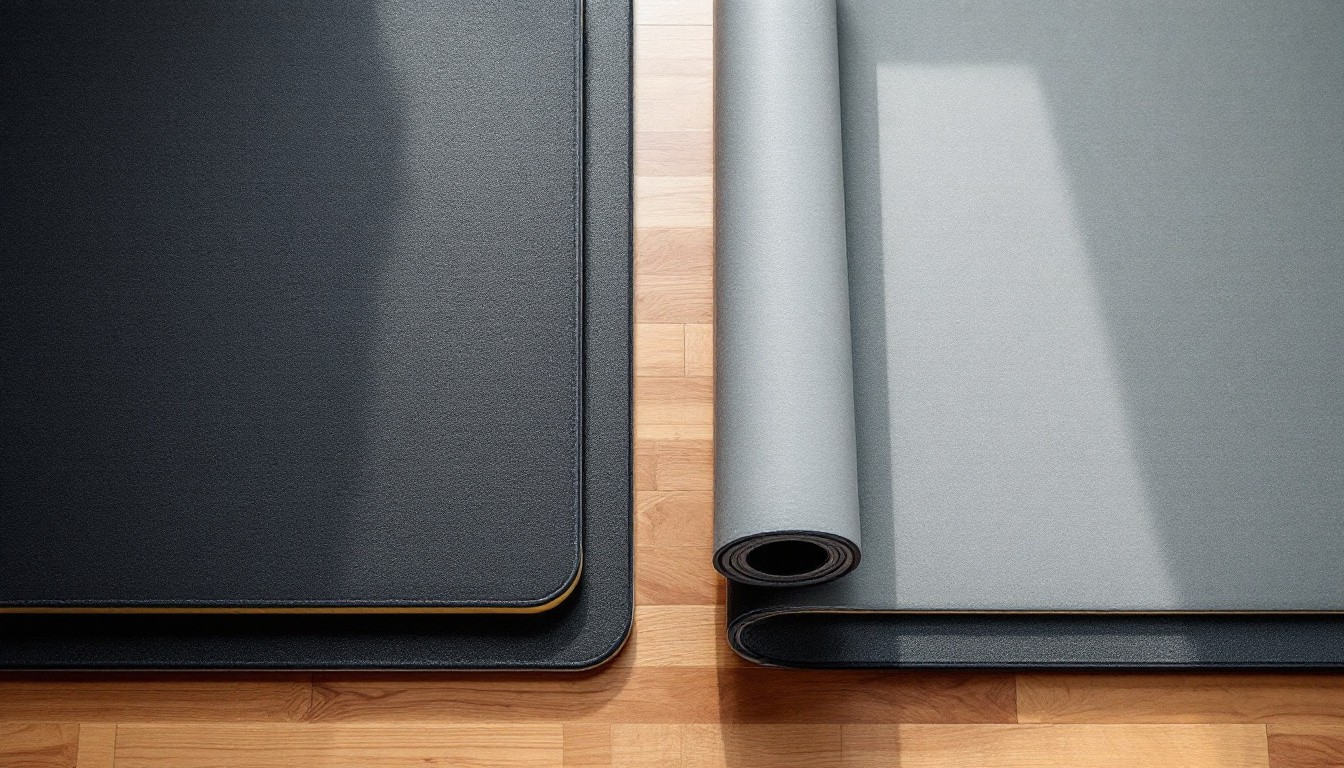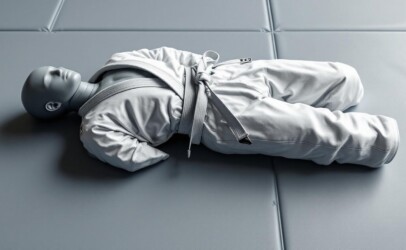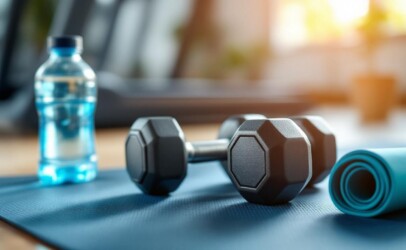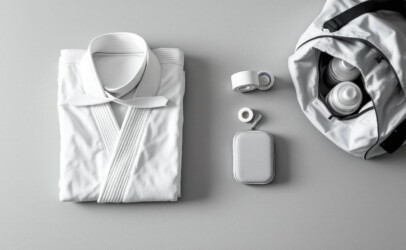Training on the wrong surface can lead to injuries and poor technique development. A quality jiu jitsu mat makes the difference between productive sessions and wasted time.
We at Jiu jitsu know that selecting the right mats depends on your specific training needs, space, and budget. The wrong choice costs money and compromises your progress.
Which Mat Type Suits Your Training Style
Three main mat categories dominate the training market, each serving specific purposes and environments. Puzzle mats feature interlocking edges that create seamless surfaces, making them ideal for home gyms where space flexibility matters most. These modular systems allow you to expand or reduce your area based on daily needs, and individual pieces replace easily when damaged.
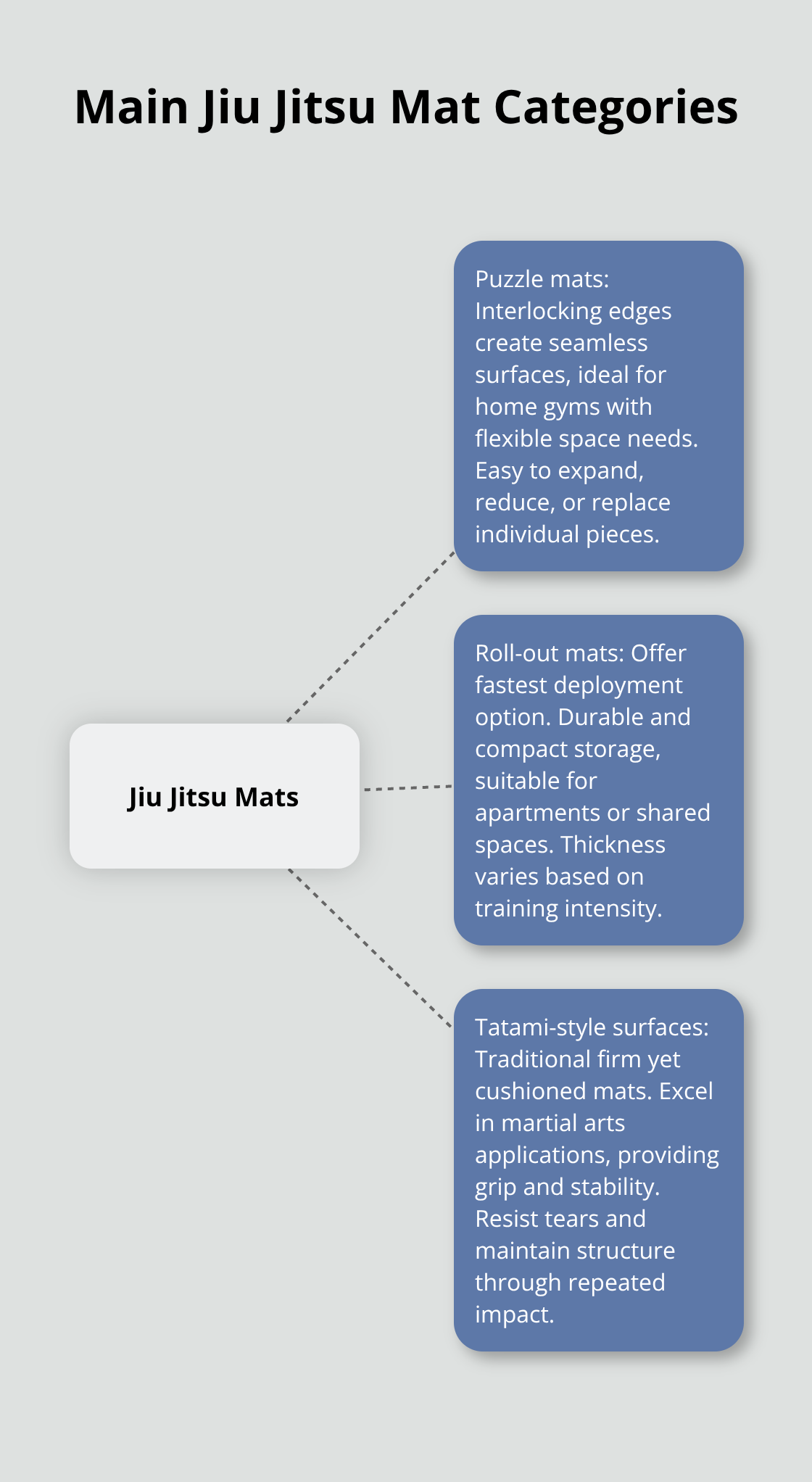
Puzzle Mats for Versatile Training Spaces
The ProsourceFit Puzzle Exercise Mat stands out with its waterproof material and easy cleaning properties, perfect for high-intensity workouts that generate sweat. These interlocking systems adapt to irregular room shapes better than large rolls, and you can configure them to match your exact space requirements. The modular design means damaged sections replace individually (saving money on full mat replacement), while the interlocking edges prevent gaps that could cause trips or falls during movement.
Roll-Out Mats for Quick Setup
Roll-out mats offer the fastest deployment option for sessions. The Flooring Inc 8mm Rubber Rolls provide superior durability with minimal odor compared to standard rubber alternatives. These mats work exceptionally well in apartments or shared spaces because they store compactly when rolled up. Thickness matters significantly here – options above 8mm deliver better shock absorption for regular weightlifting, while thinner versions suit yoga and light cardio. Installation requires carpet tape to prevent movement during intense sessions.
Tatami-Style Surfaces for Martial Arts
Tatami mats bring traditional surfaces into modern environments. These firm yet cushioned options excel in martial arts applications where grip and stability take priority over maximum cushioning. The firmness, shock absorption, and high-grip textured surface make them ideal for pivoting, kicking, grappling, and other standing work. Quality tatami surfaces resist tears and maintain their structure through repeated impact, making them the preferred choice for serious martial artists who train multiple times weekly, especially for no gi training.
The surface characteristics of your chosen mat directly impact safety and performance (particularly grip and shock absorption), which leads us to examine the technical features that separate good mats from great ones.
What Technical Specs Actually Matter
Mat thickness determines your joint protection and comfort more than any marketing claim. Mats under 6mm fail to provide adequate cushion for knees and hips during ground work, while options between 8-15mm deliver optimal impact absorption. The REP Exercise Mat offers 1.5 inches of thickness for high-impact sessions, though its surface can become slippery during intense workouts. Density matters equally – high-density closed-cell foam resists compression and maintains structure through repeated impact, while cheap open-cell alternatives flatten within months of regular use.
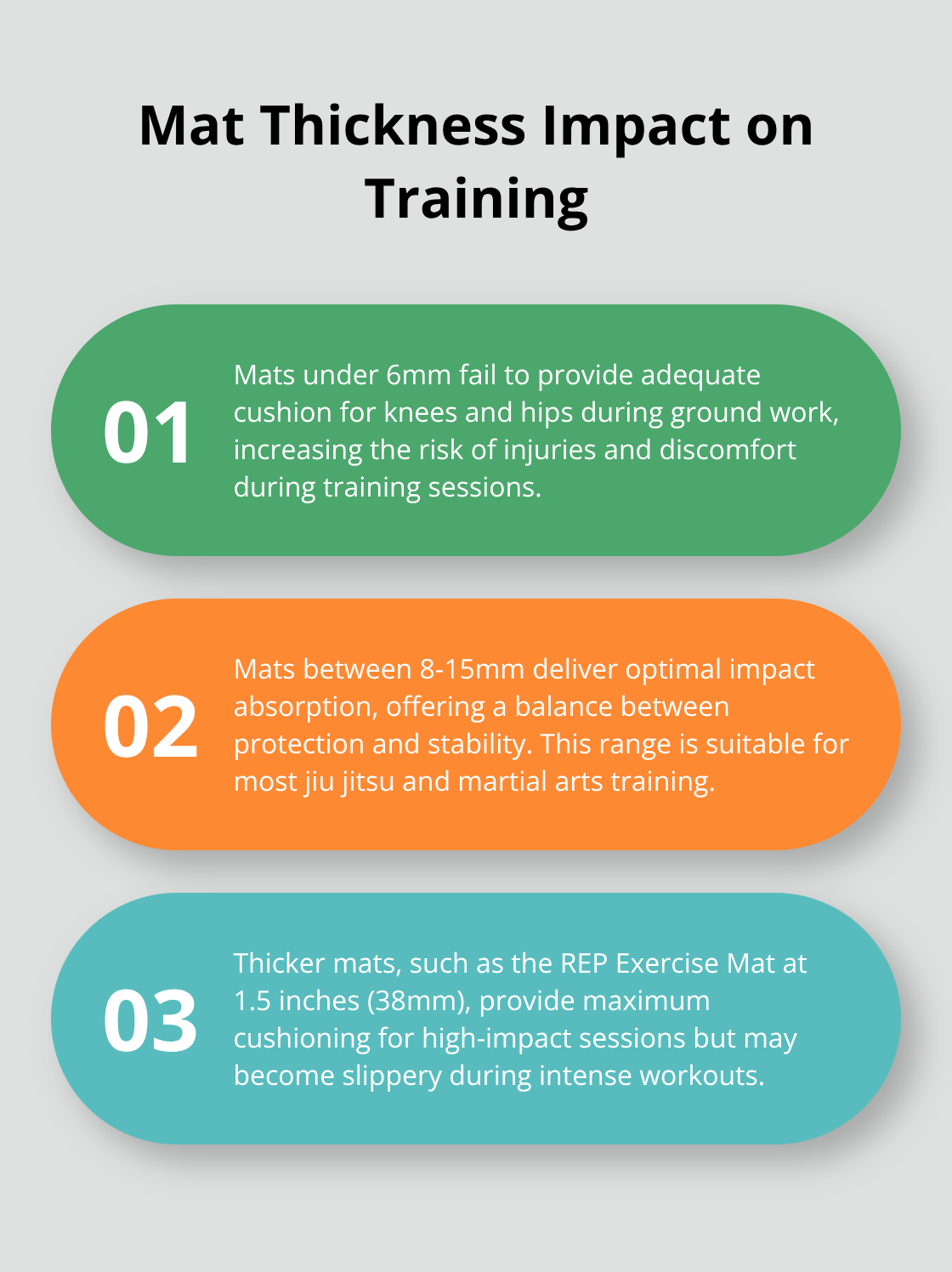
Surface Grip Prevents Injuries
The Retrospec Laguna Yoga Mat maintains traction even when wet and sticks securely to floors and hands during sweaty sessions. Surface texture directly affects safety – smooth surfaces become dangerous when moisture appears, while aggressive textures can cause skin abrasions during ground movements. Natural rubber surfaces provide superior grip compared to PVC alternatives, especially in hot yoga or intense grappling scenarios. Cork surfaces offer antimicrobial properties and improve grip as they absorb moisture (making them ideal for practices that involve significant sweat).
Maintenance Requirements Shape Long-Term Value
Waterproof mats like the ProsourceFit Puzzle system wipe clean after workouts, while porous materials require deep cleaning and extended drying times. The Jade Harmony mat needs frequent cleaning due to its porous natural rubber construction and adds maintenance time to your routine. Chemical odors from new mats require off-gassing in ventilated areas before use – the Flooring Inc 8mm Rubber Rolls produce minimal odor compared to standard alternatives. Machine-washable options like the Brentwood Home yoga mat eliminate cleaning hassles entirely, though few mats offer this convenience due to thickness constraints.
Durability Standards Affect Performance
High-quality mats resist wear and maintain their properties through thousands of training sessions. The BalanceFrom 2″ Thick Tri-Fold Mat features a heavy-duty cover that protects against wear and tear while providing good ankle and wrist support. Cheaper alternatives show compression marks and surface damage within months (particularly in high-traffic areas where you perform the same movements repeatedly). Quality construction materials determine whether your mat investment lasts years or requires frequent replacement.
These technical specifications directly influence how well your mat performs in different environments, which varies significantly between home and commercial gym settings.
Home Training vs Commercial Gym Mat Needs
Home training mats face different demands than commercial gym equipment and require smart compromises between performance and practicality. The Gxmmat Oversized Mat provides 72″ x 48″ coverage for around $110 and offers sufficient space for most home workouts while it stores in a standard closet when rolled. Apartment dwellers should prioritize the Second Skin Stomp Mat for noise reduction – this specialized underlayment prevents complaints from neighbors during heavy lift sessions.
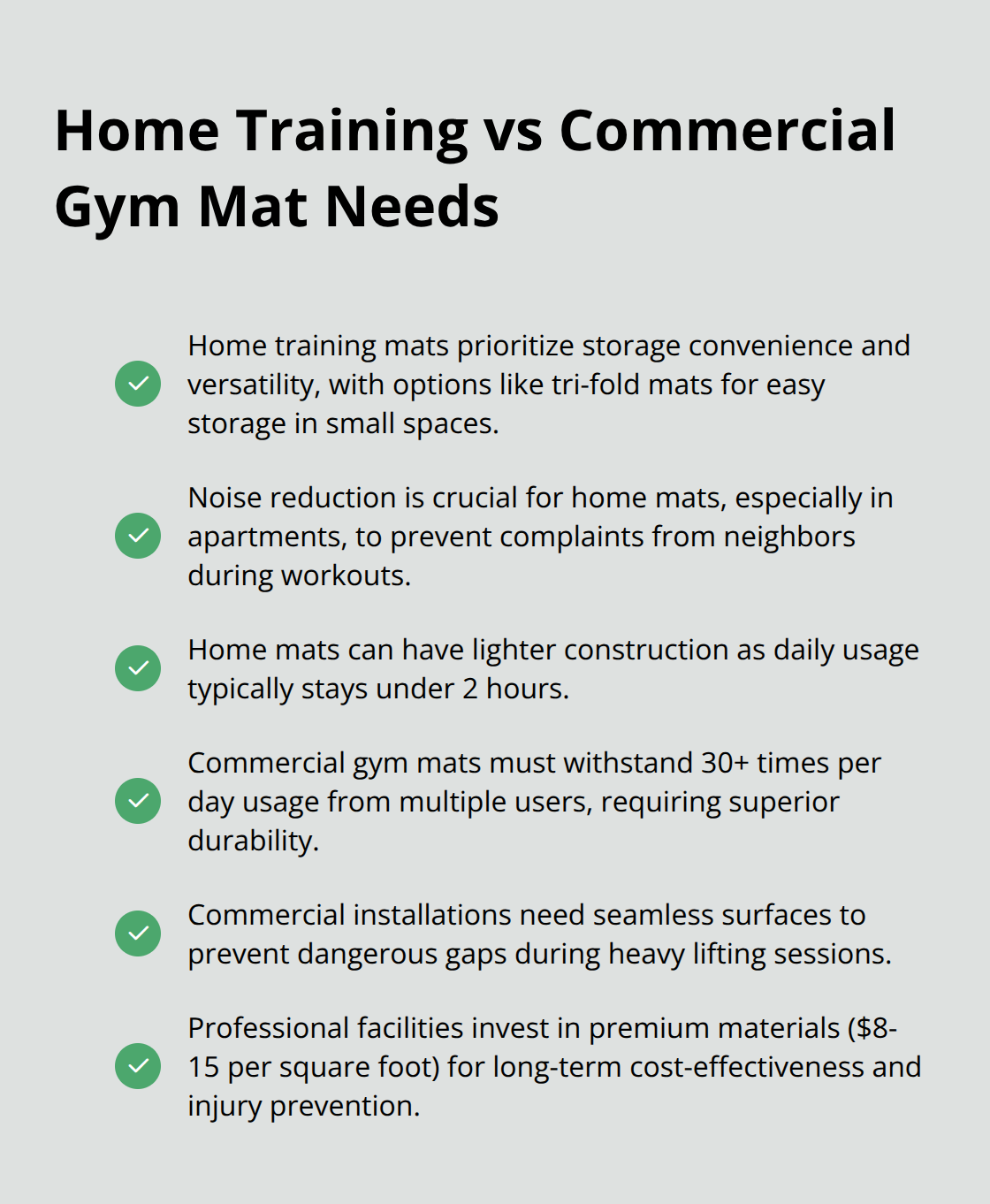
Storage constraints make tri-fold mats like the BalanceFrom 2″ option superior to rolls in small spaces, though they cost 20-30% more per square foot. Home users can accept lighter construction since daily usage stays under 2 hours (while commercial facilities see extensive daily use). The HemingWeigh Extra Thick Foam mat delivers adequate durability for casual training at budget prices under $50.
Commercial Grade Performance Standards
Commercial gyms demand mats that withstand 30+ times per day usage from multiple users. The PLAE Forge 12mm thick flooring receives 5-star durability ratings for high-impact training environments and handles weights exceeding 300 pounds without permanent compression. Tractor Supply ¾” Rubber Stall Mats became the industry standard because they cost $40-50 per 4×6 foot section while they last 5-7 years under heavy use.
Commercial installations require seamless surfaces – the Living.Fit interlocking system stays locked during heavy lifting where cheaper alternatives separate and create dangerous gaps. Professional facilities invest $8-15 per square foot in premium materials because replacement costs and injury liability make cheap options expensive long-term. The Manduka PRO mat’s lifetime guarantee makes sense for studios that run 20+ classes weekly, though the $125 price point exceeds most home budgets.
Investment Analysis for Different Usage Patterns
Training frequency determines your optimal price point more than mat quality marketing claims. Users who train 2-3 times weekly should invest in mid-range options like the Nike Training Mat 2.0 at $60, which provides 3-5 years of reliable service. Daily trainers need commercial-grade materials – spending $200-400 on professional flooring saves money compared to replacing budget mats annually.
The Gaiam Essentials mat under $20 works for beginners who train once weekly, though expect replacement within 18 months of regular use. Calculate cost per training session rather than upfront price – a $100 mat that lasts 5 years costs $0.38 per session for daily users (while a $30 mat requiring yearly replacement costs $0.58 per session).
Final Thoughts
Your training goals determine the right jiu jitsu mat choice more than price or brand reputation. Beginners who train twice weekly succeed with budget options like the Gaiam Essentials mat, while daily practitioners need commercial-grade materials that withstand intensive use. The ProsourceFit Puzzle system works well for home spaces that require flexibility, while roll-out options suit those who prioritize quick setup and storage.
Quality mats transform your training experience through consistent grip, proper cushioning, and reliable durability. Poor surfaces lead to injuries and technique problems that cost more than premium mat investments. Calculate cost per training session rather than upfront price since a $100 mat that lasts five years costs less per use than cheap alternatives that require annual replacement.
Start with your space constraints and training frequency to narrow your options. Apartment dwellers need noise-dampening features, while home gym owners can prioritize size and modularity. We at Souza Grappling Co. help students develop proper technique on professional-grade surfaces in our facility that offers Jiu-Jitsu, Muay Thai, and specialized programs for all skill levels.

